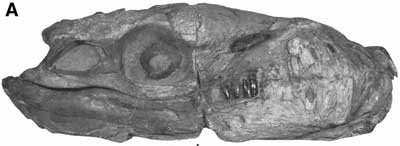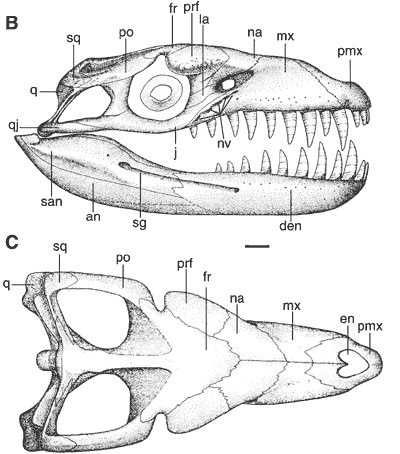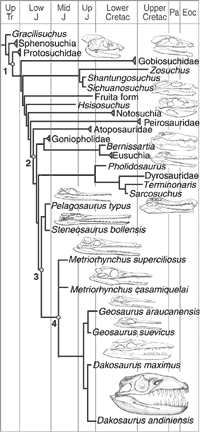You call that a crocodile?
Here's a cool beast from the late Jurassic/early Cretaceous that tells us a little more about the past diversity of crocodilians. It's called Dakosaurus andiniensis, and all we have of it is a skull and a few fragmentary post-cranial bits. It's a strange, strange skull, though.


D. andiniensis MOZ 6146P in (A) right lateral view. Skull reconstruction in lateral (B) and dorsal (C) views (based on left and right sides). Scale bars, 5 cm. Abbreviations: an, angular; den, dentary; dt, dentary tooth; en, external nares; eoc, exoccipital; fr, frontal; ic, internal carotid foramen; la, lacrimal; mt, maxillary tooth; mx, maxilla; na, nasal; nv, neurovascular foramina; pmx, premaxilla; po, postorbital; prf, prefrontal; pt, pterygoid; q, quadrate; qj, quadratojugal; san, surangular; sg, surangular groove; soc, supraoccipital; sq, squamosal.
When we think of a crocodilian, we picture either a flat, broad skull with many conical teeth, or if you're more familiar with reptilian exotica, something like the gharial, with a long narrow snout and numerous sharp teeth. These are adaptations for rapid side-to-side flicks of the head in the water, and for snagging prey.

Phylogenetic relationships of Crocodyliformes obtained in the cladistic analysis, plotted against geochronologic epochs (strict consensus of most parsimonious trees; some taxa distantly related to D. andiniensis collapsed into triangular clades). Only skull figures of Thalattosuchia were drawn to the same scale. Numbered nodes: 1, Crocodyliformes; 2, Neosuchia; 3, Thalattosuchia; and 4, Metriorhynchidae.
Dakosaurus is different: it has a relatively short, deep skull, with relatively few teeth that are sharp-edged and serrated. It's a most non-crocodilian skull, as far as the overall morphology goes, but the details tie it quite clearly to a specific lineage of ancient crocodilians.
It belongs to the Thalattosuchia, specifically the Metriorhynchids, which were marine crocodiles. They lacked the armored plates of modern crocs, lived in the ocean, and the caudal skeletons of the lineage show an interesting downward kink in their tails—they probably had vertical flukes, like the mosasaurs. The species most closely related to Dakosaurus also had elongated skulls with swarms of small sharp pointy teeth, and like the gharial, were almost certainly great fisheaters.
Dakosaurus, though, was different. It's another marine crocodile, and it's body may have been similarly adapted to an aquatic life (although we lack direct skeletal evidence for that), instead of hooking prey by slashing through schools of fish and squid, this sea monster had a deeply muscled skull for a strong bite, and a mouthful of long daggers good for slashing. What did it eat? We don't know—we need more fossils—but it does point to some diversity we've long since lost, and suggests that those Cretaceous seas were savage places.
Gasparini Z, Pol D, Spalletti LA (2006) An Unusual Marine Crocodyliform from the Jurassic-Cretaceous Boundary of Patagonia. Science 311(5757):70-73.


"...probably had vertical flukes, like the mosasaurs."
Did mosasaurs really posess tails like this? I thought they had laterally flattened paddle-like tails, and it was the Ichthyosaurs that had the flukes. Or have I missed some new discovery about mosasaurs?